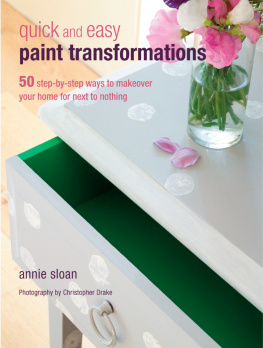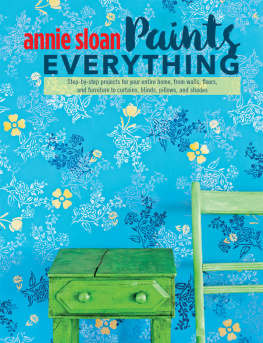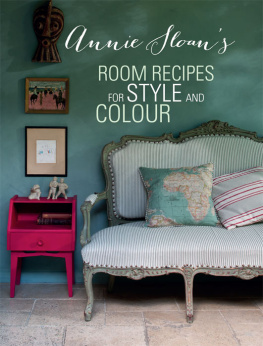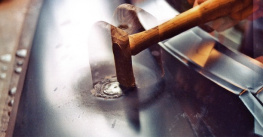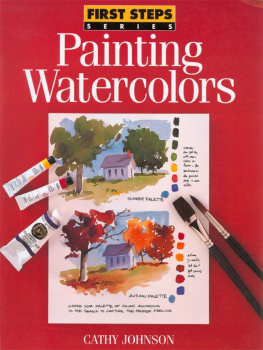

chiffonier
very textured paint

The great thing about paint is that it can hide so much and imperfections can be made into virtues with a few simple techniques. This small late-Victorian chiffonier, a sort of slim sideboard, was in very bad condition with peeling off veneer and a missing drawernot to mention the rickety state of the topbut I was able to save it from a sad fate by using paint! The drawer was replaced with a piece of wood, lots of glue was used for sticking down the peeling veneer and mending broken joints, and gaps were plugged with wood filler.

Before
Since the piece was quite complex and almost fussy, with curves, carving, moldings, and pillars, I felt the painting should be relatively plain.
You will need - Old White paint
- Paintbrushes in different sizes for applying paint
- Paper
- Tin of clear wax
- 1in (2.5cm) paintbrush for applying wax
- Cloths for removing excess wax and polishing
- Tin of dark wax
- White spirit
- Bowl
- 2in (5cm) paintbrush for applying white spirit mix
| 
|
TIP When painting around a mirror the best way to do it is to place a piece of paper along the inside edge, replacing the paper when one piece gets too sodden. Any paint that gets on the mirror can be removed later.

Step 1
Begin by painting the chiffonier in Old White with a big brush, using a jabbing rather than a sweeping technique.

Step 2
As I was using light paint on dark wood and wanted to add texture, I needed to apply three coats of Old Whiteleaving each to dry completely before applying the next.

Step 3
Apply clear wax with a brush over the paint and then wipe it with a cloth to remove any excess.

Step 4
In a bowl make a mixture of equal parts dark wax and white spirit to form a thin watery liquid.

Step 5
Working one section at a time, apply the mixture over the white paint with a brush. Wipe off the thin mixture with a cloth so the dark color is left in the recesses and texture of the paint and the raised areas are clean.

Step 6
In some places you might want to remove some of the dark wax mixture if the result is too dark. To do so just use a tiny amount of clear wax on your cloth and rub the wood until you are happy with the finish. See .

textured paint cabinet
distressing with brown wax

For this project Ive chosen Monet Blue, a bright Mediterranean color postioned toward the green end of the blue spectrum, which will turn a beautiful, rich, sophisticated blue with the application of the dark, tan-colored wax. To achieve a finish in this rich color you need to start with a bright paint, but bear in mind the effect that the tan wax will have on the finished piece.
Before
Simple little cabinets such as this one are very adaptable, but they can look a little bland if painted too plainly. I felt it was necessary to add a splash of bright color, then tone it down slightly with the application of dark wax.
You will need - Monet Blue paint
- 2in (5cm) paintbrush for applying paint
- Tin of dark wax
- 1in (2.5cm) paintbrush for applying wax
- Cloth for removing excess wax
- Tin of clear wax (optional)
| 
|
TIP To achieve a good texture with your paint, allow it to thicken slightly as described . Using brush strokes in many different directions and going back over an area that has begun to dry will create additional texture. Dont worry about trying to keep the finish consistent throughout.

Step 1
Paint all over the cabinet unevenly, making brush marks in all directions. Allow the paint to dry thoroughly. This may take slightly longer than usual as the paint will be thicker in some places.

Step 2
Apply a second coat, again thickly and unevenly. It is a good idea to return to an area of paint that has begun to dry a little and make more apparent brush marks. Try stabbing the brush in just a few areas to make a different texture.

Step 3
When the paint is thoroughly dry apply the dark wax to the whole of the chest one side at a time, making certain the brush goes in several directions to get into the texture of the paint.

Step 4
Wipe off the wax with a clean cloth quite firmly. The idea is that the dark wax stays in the textured surface of the paint. If you find that too much of the dark wax is being removed then leave it on to dry out a little more. Conversely, if too much dark wax is staying on the cabinet then use some clear wax to clean it off. If you leave the wax until it dries then it becomes difficult to remove. See .

Next page
